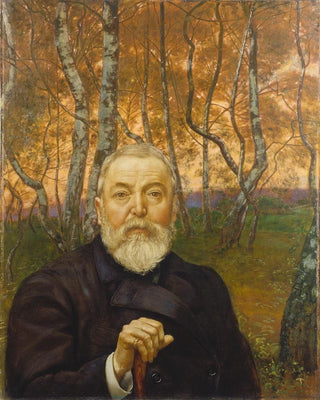Art print | Self-portrait in front of a birch forest - Hans Thoma


View from behind

Frame (optional)
In the fascinating world of art, some works transcend the mere frame to become windows into the artist's soul. "Autoportrait devant une forêt de bouleaux" by Hans Thoma is one of those creations that capture not only the image of a man but also the essence of a spirit in search of truth and beauty. This piece, both intimate and universal, evokes a dialogue between the artist and nature, inviting the viewer to immerse themselves in a universe where every detail resonates with emotional depth. The art print Autoportrait devant une forêt de bouleaux - Hans Thoma allows for rediscovering this masterpiece, offering a unique opportunity to contemplate the harmonious fusion between the individual and their environment.
Style and uniqueness of the work
Thoma's work stands out for its vibrant style and its ability to evoke emotions through carefully constructed landscapes. In this self-portrait, the artist places himself at the heart of a birch forest, a symbolic choice that illustrates his attachment to German nature. The colors, rich and nuanced, create an almost mystical atmosphere, where light filters through the trees, casting delicate shadows on the artist's face. This contrast between the individual and nature suggests a duality, a tension between the human being and their environment. Thoma's technique, which combines realism with a touch of romanticism, allows one to feel the depth of his thoughts and reflections. Every brushstroke seems charged with meaning, every detail meticulously chosen to tell a story.
The artist and his influence
Hans Thoma, born in 1839, is an emblematic figure of the German artistic movement of the 19th century. His career is marked by a constant search for harmony between man and nature, a theme that echoes in many works. Influenced by Romanticism and Realism, Thoma developed a personal style that allowed him to stand out from his contemporaries. He was also a fervent advocate of folk art, seeking to incorporate elements of folklore and German culture into his creations. This art print, far from being a simple

Matte finish

View from behind

Frame (optional)
In the fascinating world of art, some works transcend the mere frame to become windows into the artist's soul. "Autoportrait devant une forêt de bouleaux" by Hans Thoma is one of those creations that capture not only the image of a man but also the essence of a spirit in search of truth and beauty. This piece, both intimate and universal, evokes a dialogue between the artist and nature, inviting the viewer to immerse themselves in a universe where every detail resonates with emotional depth. The art print Autoportrait devant une forêt de bouleaux - Hans Thoma allows for rediscovering this masterpiece, offering a unique opportunity to contemplate the harmonious fusion between the individual and their environment.
Style and uniqueness of the work
Thoma's work stands out for its vibrant style and its ability to evoke emotions through carefully constructed landscapes. In this self-portrait, the artist places himself at the heart of a birch forest, a symbolic choice that illustrates his attachment to German nature. The colors, rich and nuanced, create an almost mystical atmosphere, where light filters through the trees, casting delicate shadows on the artist's face. This contrast between the individual and nature suggests a duality, a tension between the human being and their environment. Thoma's technique, which combines realism with a touch of romanticism, allows one to feel the depth of his thoughts and reflections. Every brushstroke seems charged with meaning, every detail meticulously chosen to tell a story.
The artist and his influence
Hans Thoma, born in 1839, is an emblematic figure of the German artistic movement of the 19th century. His career is marked by a constant search for harmony between man and nature, a theme that echoes in many works. Influenced by Romanticism and Realism, Thoma developed a personal style that allowed him to stand out from his contemporaries. He was also a fervent advocate of folk art, seeking to incorporate elements of folklore and German culture into his creations. This art print, far from being a simple






